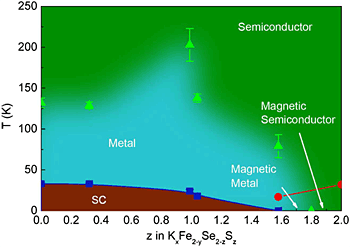Scientists “Dial In” Superconductivity and Semiconductivity in Same Material
February 3, 2012

Magnetic and superconducting phase diagram of KxFe2-ySe2-zSz, showing the critical temperature, T(K), as a function of the degree of sulfur doping (z=0 denotes no sulfur). Green, blue, and orange colors show semiconducting, magnetic, and superconducting regions, respectively.
In the last few years, researchers working in the field of superconductivity have become increasingly interested in a class of iron-based materials that exhibit some unusual characteristics. Recently, Brookhaven National Laboratory scientists studying one such material were able to fully suppress its superconducting state — turning it from a superconductor to a magnetic semiconductor — by tweaking its atomic structure. This work may open up a new route to understanding and manipulating superconductors.
The superconductor is composed of the elements potassium (K), iron (Fe), and selenium (Se). It has a crystal structure, with alternating K and FeSe layers, and is intriguing because it doesn’t display the same electronic characteristics as other iron-based superconductors.
The scientists managed to synthesize a series of single crystals in which the Se atoms were substituted with varied amounts of sulfur (S). They used x-ray light at the National Synchrotron Light Source to study how “doping” the material affects its structural properties. They correlated these changes with the changes in its magnetic and electronic transport properties and superconducting critical temperature (the temperature below which it superconducts).
The work is described in the September 23, 2011, online edition of Physical Review Letters.
The type of doping in this case is known as isovalent substitution, where one type of ion in the material is replaced by an ion of the same oxidation state — that is, gains or loses the same number of electrons when it binds to another atom. Here, the S atoms replace Se atoms in the crystal lattice. Among the iron-based superconductors, doping is a tool used to induce superconductivity in a parent material or to improve its performance.
“Due to subtle changes in atomic occupancies at the Fe and K sites, profound changes resulted in the material’s electronic properties,” said the study’s lead scientist, Brookhaven Lab physicist Cedomir Petrovic. “As the sulfur entered the lattice, superconductivity was suppressed and a rich variety of electronic ground states emerged. The overall electronic system was tuned from a superconducting metal at low temperatures (no sulfur in the lattice) to a magnetic semiconductor (all Se sites occupied by sulfur).”
The group prepared several samples with varying amounts of sulfur, and placed each one in the path of an intense x-ray beam. Via a process called x-ray diffraction — studying how the x-rays scattered off electrons in the material as they passed through it — they were able to “see” how the addition of the sulfur induced average structural changes in the material.
They discovered that with increased amounts of sulfur the material’s critical temperature dropped, and superconductivity eventually vanished when the sulfur substitution level reached 80 percent.
Structurally, the sulfur doping caused the crystal lattice to contract, making the Fe-Se(S) tetrahedron (a square with Fe at each corner and Se or S in the middle) more irregular. This behavior appears to be the root of the critical temperature drop, since the substitution alone — with sulfur roughly “equal” to selenium — should not be the cause. This suggests that the critical temperature is not solely governed by the relative quantities of K and Fe. The researchers show that, rather, small structural changes caused by the sulfur substitution — in particular, the environment around one of the two Fe atoms in the crystal’s unit cell — ultimately leads to changes in the material’s electronic and magnetic behaviors. Together, these changes forced the critical temperature to fall and suppressed the material’s superconducting ability.
2012-2882 | INT/EXT | Newsroom









